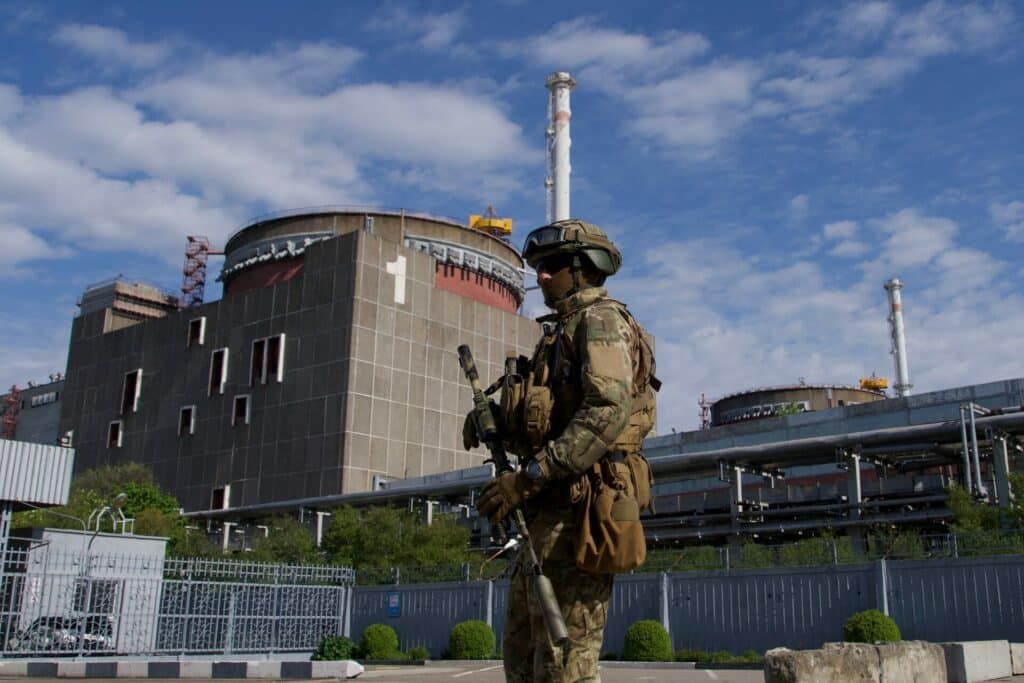Zaporizhzhia on the brink: How deteriorating conditions at the nuclear power plant could lead to disaster
By Zakhar Popovych, Denys I. Bondar, M.V. Ramana | October 7, 2022
 A Russian serviceman patrols the territory of the Zaporizhzhia Nuclear Power Plant on May 1, 2022. The Zaporizhzhia Nuclear Power Plant in southeastern Ukraine is Europe's largest and among the 10 largest in the world. (Editor's note: This picture was taken during a media trip organized by the Russian army.) (Photo by ANDREY BORODULIN/AFP via Getty Images)
A Russian serviceman patrols the territory of the Zaporizhzhia Nuclear Power Plant on May 1, 2022. The Zaporizhzhia Nuclear Power Plant in southeastern Ukraine is Europe's largest and among the 10 largest in the world. (Editor's note: This picture was taken during a media trip organized by the Russian army.) (Photo by ANDREY BORODULIN/AFP via Getty Images)
Soon after it started its invasion of Ukraine on February 24, 2022, the Russian military occupied the southern part of the Zaporizhzhia region. The occupied area includes the territory of the Zaporizhzhia Nuclear Power Plant (NPP), the largest in Europe. During the summer, the area around the Zaporizhzhia NPP was hit multiple times by missiles and artillery. These affected all high-voltage electric power lines that connect the facility to the grid, so the plant was forced to work for some time in island mode, using the minimal power produced by one of the reactors to maintain functions essential to the plant’s safety. After the International Atomic Energy Agency (IAEA), the UN’s nuclear watchdog, conducted its inspection on September 1st, Ukrainian maintenance teams were allowed by the Russian military to repair the power lines and refill the diesel fuel storage tanks needed for emergency power generators. This made it possible to supply the facility with external power for the reactor cooling and other maintenance systems.
On September 10, the three of us had a conversation via Zoom with Pavlo Oleshuk, a representative of Atomprofspilka, the nuclear energy and industry workers’ union of Ukraine. Oleshuk is an experienced member of the team that operates the Rivne NPP in northwest Ukraine. As an organizer with the union, he has been in close and constant contact with the employees who directly operate the Zaporizhzhia NPP.
Oleshuk’s descriptions gave us new insight into the working and living conditions of his colleagues at the beleaguered plant. Such details have been otherwise difficult to get as plant operators have avoided talking in public ever since Russian forces seized the plant. Our discussion with Oleshuk lasted for more than two hours, and we offer here the main insights.
At the time we talked to Oleshuk, one of the reactors at the Zaporizhzhia NPP was still operating. However, shortly after our conversation, EnergoAtom, the Ukrainian state nuclear power plant operator, decided to shut down all reactors there. Despite this decision, there is a continued risk of a major nuclear incident as the plant requires permanent cooling. Furthermore, as our discussion with Oleshuk reveals, other factors exacerbate the fragility of the situation at the Zaporizhzhia NPP.
Context. Oleshuk began with a description of Zaporizhzhia NPP and the city of Energodar, which means literally “the gift of energy.” It was a common practice in the Soviet nuclear power industry to build new cities just next to a nuclear power plant to offer the personnel and their families all the infrastructure they needed for a comfortable life—what the Russians call “monotowns.” Energodar was one of those cities built to house the workers at the Zaporizhzhia NPP, just like the city of Pripyat in northern Ukraine was built to house the operators of the Chernobyl NPP before it was evacuated after the devastating 1986 accident.
Energodar was home to about 50,000 people. The closest residential building is just 3 kilometers (1.8 miles) from the reactors. Although some of the employees have sent away their families, especially children, most are still living there. This is in part because in many households both parents work at the nuclear plant.
Working under threats and intimidation. The Zaporizhzhia NPP, the city of Energodar, and the surrounding areas have all been under Russian occupation for the past few months. According to Oleshuk’s sources at the plant, Russian armed forces first took control of the nearby territory and peacefully approached the personnel of the power plant claiming that they would not intervene with the operations of the plant. But once the armed forces entered the plant’s premises, so did personnel from the FSB—Russia’s principal security agency and successor to the old KGB—and a couple of experts from Rosatom, the Russian state nuclear energy corporation. But the Rosatom personnel, Oleshuk’s sources said, have not done much, and most Ukrainian plant operators suspect that they are present solely to make it look as though Russia had taken responsibility for the plant’s operation by bringing in experts.
For their part, the FSB personnel, unlike regular soldiers, violated the rules about who can access different areas of the plant and went everywhere within the premises, including inside radiation-controlled zones. But rather than taking control over the plant’s operations, the FSB agents seem to have been tasked with finding the so-called “ringleaders” who are organizing protests against the occupation because they seem to believe that such protests are organized by some Ukrainian intelligence agents—while, in reality, they spring from the grassroots. The FSB agents apparently hope that by arresting these figures, the protests will die down. Consequently, FSB personnel have been interviewing plant employees as well as the residents of Energodar. Workers are stopped at checkpoints on their way to the plant and arrested for questioning or ordered to report the next day to the FSB office for interrogation. According to Oleshuk’s sources, these practices became more prevalent with time. [On October 2, even the director general of the Zaporizhzhia NPP, Ihor Murashov, was detained; he was released the following day.] From the viewpoint of plant workers, the FSB’s actions look like a deliberate policy of threats and intimidation.
Over time, many more nuclear power plant workers have left Energodar for other cities that are still under the control of the Ukrainian government, creating a shortage of personnel at the Zaporizhzhia NPP. Even though some nuclear power plant maintenance functions can be carried out remotely, most cannot. As a result, there are concerns about the safety of these reactors and their associated systems.
Living without supplies. Because it is in Russian-occupied territory, residents of Energodar can no longer get their supplies from Ukraine-controlled territories, although they are located just across the Dnipro River. Instead, they must get them from other occupied territories—which means that even the supply of basic groceries is intermittent, with some food products simply no longer available. For example, children with lactose allergies have no access to lactose-free milk. This problem is also true for the supply of medicine, especially the drugs needed to treat diabetes and other chronic illnesses. Russian occupation authorities are worsening the situation by blocking the supply and distribution of humanitarian aid coming from mainland Ukraine. Recently, they effectively closed the city’s main distribution center by evicting it from the premises it had been using for storing and sorting humanitarian aid.
Another major problem for the residents of Energodar is the collapse of utilities. Ironically for a city hosting Europe’s largest nuclear power plant, the electricity supply has been almost shut off. On most days, people get electricity only for two hours, with at least one period where there was no electricity at all for several consecutive days. Without electricity, food and medicines stored in refrigerators get spoiled, and phones and power banks run out of charge. People have been forced to turn to fireplaces, installed in the yards of their apartment buildings, to cook food with wood.
The supply of water supply has also become a problem since it relies exclusively on electric pumps and there are no water towers in Ukraine because the electricity supply was always considered to be reliable and abundant. As a result, people have lacked running water in their homes for days. In the city of Energodar, located on the bank of the Dnipro River, there has been some limited water supply for cooking reported, but inhabitants lack access to clean drinking water and can’t have showers for days at a time.
Outlook. With winter coming, the future is grim for the workers of the Zaporizhzhia NPP who still live in Energodar. Like other satellite cities, Energodar relies on the Zaporizhzhia NPP for most of its energy needs, including for heating. The city does have a backup thermoelectric power station that can work on coal, fuel oil, and gas, but that facility was shut down in May 2022 due to the lack of fuel since the Russian occupation started. It is an ironic situation given that the nearby Donbas region in eastern Ukraine is home to one of the world’s largest coal mining regions.
If both nuclear and thermal power plants cannot resume operation, then Energodar’s inhabitants will not be able to heat their living premises. The Ukrainian winter is cold with temperatures often being less than 20 degrees Celsius below zero (-4 degrees Fahrenheit). Plant workers don’t know how they will survive the winter.
Making an already desperate situation worse, there has been a loss of leadership and governance. The mayor of Energodar, Dmytro Orlov, was initially arrested by the Russians, but later managed to flee the city. The occupying forces did try to take over the city hall, but effectively the local authority has largely collapsed. The inhabitants are now left on their own.
According to Oleshuk, the situation is simply no longer tenable for the plant workers who are exhausted and stressed out. If the heating, water, and electricity supply are not restored within the next month or so, Energodar, the gifted city, will be not livable and inhabitants may decide to flee on their own. This situation leads to the risk of the plant being without the personnel needed for its safety.
A new concern emerged about what might happen following the fake referendums organized by Russia in the occupied territories, including the Zaporizhzhia region. One such referendum has been held in the area surrounding Energodar, which strongly suggests that Russia doesn’t want to withdraw from the area.
The only feasible path to ensure the safety of the nuclear power plant and avoid possible accidents would be to have Russian troops withdraw from Energodar and the area around the Zaporizhzhia nuclear power plant, as well as the establishment of a demilitarized zone under international supervision. If such actions are not taken now, Europe and the world should prepare for the safety and security situation at Zaporizhzhia to deteriorate within the next few weeks and, with it, an accompanying increase in the risk of a major nuclear accident.
Together, we make the world safer.
The Bulletin elevates expert voices above the noise. But as an independent nonprofit organization, our operations depend on the support of readers like you. Help us continue to deliver quality journalism that holds leaders accountable. Your support of our work at any level is important. In return, we promise our coverage will be understandable, influential, vigilant, solution-oriented, and fair-minded. Together we can make a difference.
Keywords: IAEA, Russia, Russia-Ukraine, Ukraine, Zaporizhzhia, Zaporizhzhia nuclear power plant, nuclear accidents, nuclear power plant
Topics: Nuclear Energy, Nuclear Risk

















I’ll be the first to comment BUT I don’t hold any hope of this being published. I came to this site hoping to find honest reporting but as far as reporting on Ukraine it’s a one sided propaganda exercise against Russia. This article is standard US BS propaganda repeated widely by European & 5 Eyes ( UK,USA, Canada, Australia & NZ) MSM. It is layered BS with some factual to make it sound reasonable to the average MSM reader. Russia did everything it could to not get involved in Ukraine but after over 14,000 Russian speaking residents in Ukraine were… Read more »